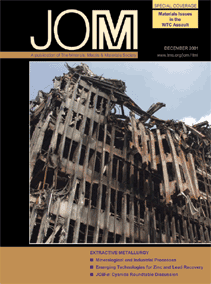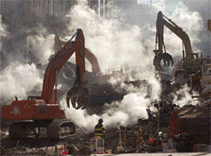 |
NEWS & UPDATE
|
|---|
 |
NEWS & UPDATE
|
|---|
|
|
|
|---|---|
 |
OTHER ARTICLES IN THE WTC
SERIES
Why Did the World Trade Center Collapse? Science, Engineering, and Speculation by Thomas Eagar and Christopher Musso Better Materials Can Reduce the Threat from Terrorism by Toni G. Maréchaux An Initial Microstructural Analysis of A36 Steel from WTC Building 7 by J.R. Barnett, R.R. Biederman, and R.D. Sisson, Jr. |
|
|
|
|
Figure 3. A month
after the World Trade Center was leveled, crews continued digging in
the smoldering debris. (Photo by Michael Rieger, FEMA)
|
 |
|
|
|
As smoke wafted from the World Trade Center site weeks after the buildings
crumbled, questions arose about how much of the debris was airborne, and the
potential danger to workers responsible for the clean-up (Figure
3). Immediately after the towers fell, the U.S. Environmental Protection
Agency (EPA) began taking samples to detect contaminants in the air, water,
river sediment, drinking water, and dust. To examine the types of particulates
in the air, a team of specialists from the University of California at Davis
was called to the scene.
The Detection and Evaluation of Long-range Transport of Aerosols (DELTA) Group
from U.C. Davis was called upon for its extensive experience in analyzing
the composition and movement of airborne particles. Since October 1, the group
had a rotating monitoring unit on the roof of a Manhattan building, downwind
from “ground zero,” continuously collecting air samples. The Davis
Rotating Unit for Monitoring collects samples in eight size ranges, from ten
micrometers to 0.09 micrometers in diameter, according to Tom Cahill, a U.C.
Davis professor of applied science at atmospheric sciences.
“Then, we apply a number of techniques, including a synchrotron x-ray
microprobe, to scan elements from sodium to uranium,” Cahill said. “With
these data, we can characterize the particles that go deep into the lung and
lodge there.”
The first batch of samples were sent to U.C. Davis in early November, for
analysis at the Lawrence Berkeley National Laboratory’s Advanced Light-Source
Lab. There, scientists examined the samples for health threats such as inhalable
particles, toxic metals, asbestos, and byproducts of burning plastic.
The DELTA Group’s assistance was requested by the U.S. Department of
Energy shortly after excavation began at the site. With the information gleaned
from the sampling, environmental experts will be able to determine whether
safety gear has been adequate and if workers need to take additional steps
to protect local residents. The first samples were to have been returned by
mid November, with data collection continuing until authorities decide it
is no longer necessary, Cahill said.
Although the EPA monitoring has revealed high levels of pollutants such as
asbestos and dioxin in some areas tested, those levels only exceeded the agency’s
guidelines for 30 years of exposure. “These levels do not pose a short-term
health effect but should be monitored if they persist for a longer period
of time,” according to information on the EPA web site. Summaries of
the collected data, which are updated regularly, are available on that web
site, at www.epa.gov/epahome/wtc/data_summary.htm.
Direct questions about this or any other JOM page to jom@tms.org.
| If you would like to comment on the December 2001 issue of JOM, simply complete the JOM on-line critique form | |||||
|---|---|---|---|---|---|
| Search | TMS Document Center | Subscriptions | Other Hypertext Articles | JOM | TMS OnLine |